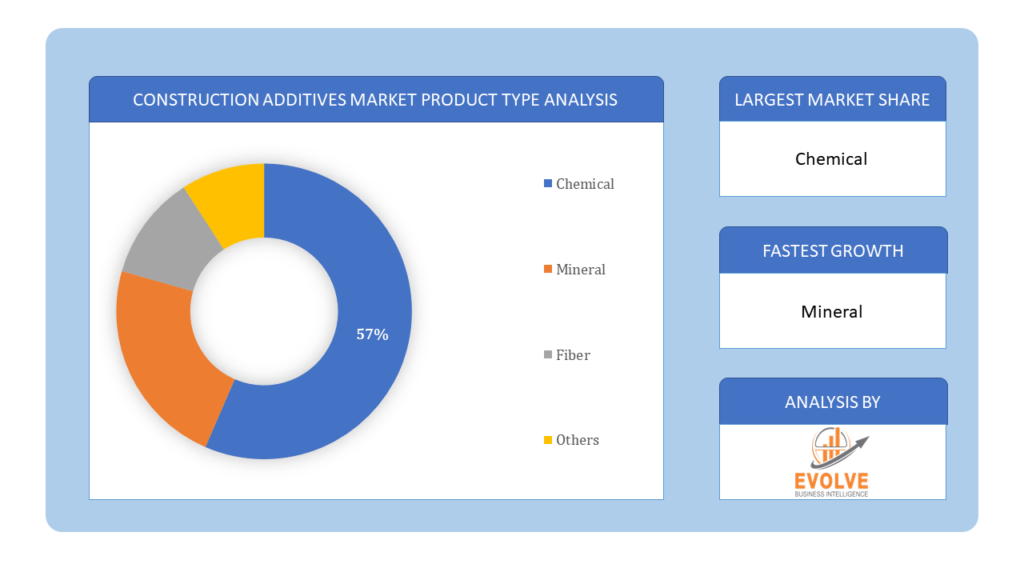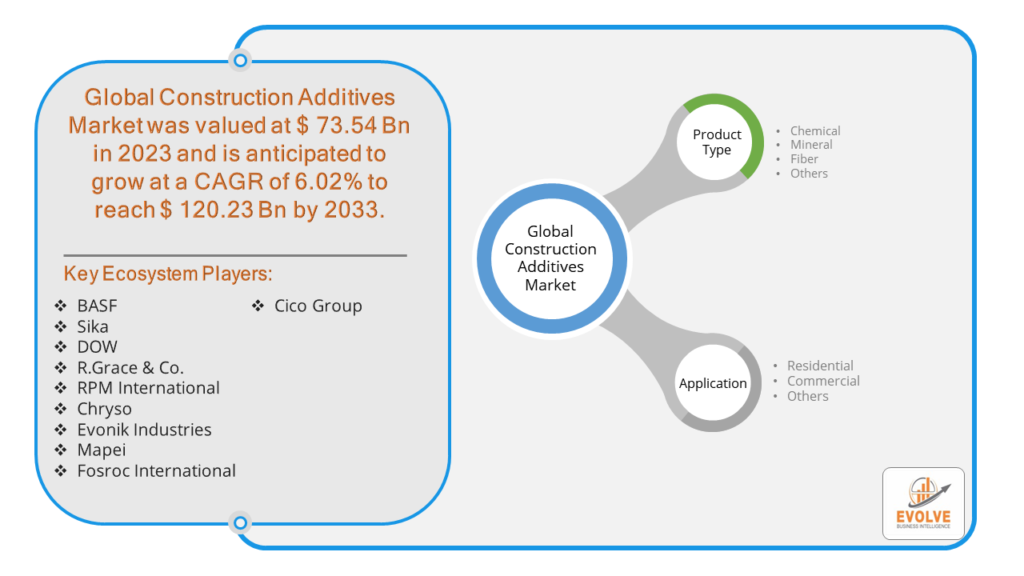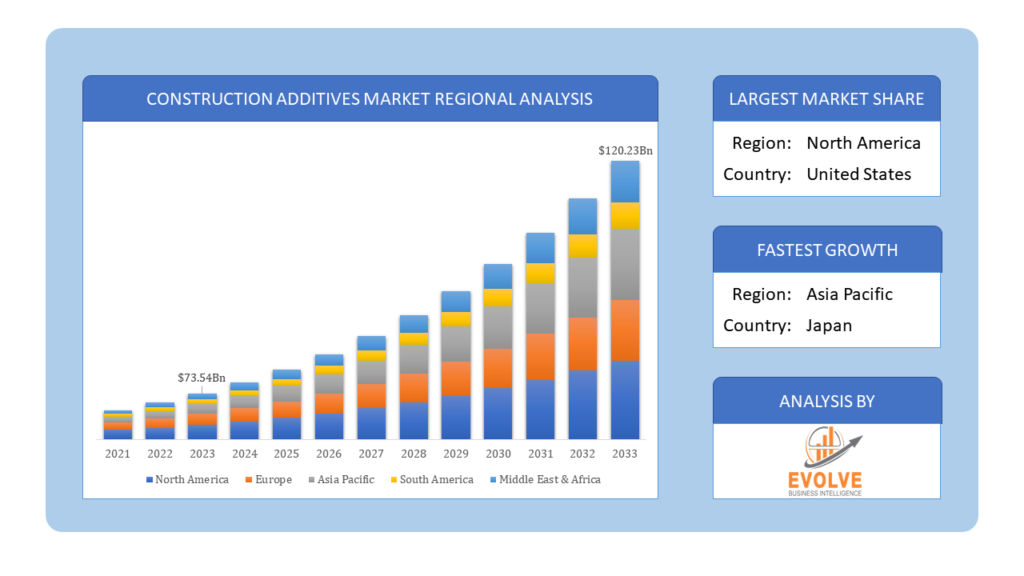Construction additives Market Overview
The Construction additives Market Size is expected to reach USD 120.23 Billion by 2033. The Construction additives industry size accounted for USD 73.54 Billion in 2023 and is expected to expand at a compound annual growth rate (CAGR) of 6.02% from 2023 to 2033. The construction additives market involves the use of chemicals and minerals to enhance the properties of construction materials like cement and mortar, improving stability, durability, and efficiency in building construction. These additives are crucial for making concrete stronger and more resistant to harsh conditions, external damage, and waterproofing. The market is primarily driven by the demand for higher quality construction materials due to rapid urbanization, significant investments in infrastructure, and a surge in construction activities in emerging economies. The construction additives market is primarily driven by the increasing demand for higher quality construction materials due to rapid urbanization, significant investments in infrastructure, and a surge in construction activities in emerging economies. This demand is further fueled by advancements in construction technologies, leading to a growing need for additives that enhance the stability, durability, and efficiency of building materials like cement and mortar
Global Construction additives Market Synopsis
Due to supply chain interruptions brought on by the COVID-19 pandemic, there are now shortages or decreased demand in the market for construction additives. Spending by consumers and businesses has decreased significantly as a result of the travel restrictions and social distancing measures, and this trend is expected to persist for some time. The epidemic has altered end-user trends and tastes, leading manufacturers, developers, and service providers to implement several measures in an attempt to stabilize their businesses.
Construction additives Market Dynamics
The major factors that have impacted the growth of Construction additives are as follows:
Drivers:
Ø Technological Advancements
Innovative additives with improved functionality and performance are developed as a result of continuous research and development activities in the building sector. As construction businesses look to use the newest technologies to improve their projects, these improvements fuel market growth.
Restraint:
- Limited Awareness and Education
It’s possible that contractors, end users, and construction professionals are unaware of the advantages construction additives offer in terms of improving sustainability and structural performance. A lack of knowledge regarding the benefits, effective selection, and usage of additives may prevent the industry from expanding.
Opportunity:
⮚ Advancements in Nanotechnology
With the help of nanotechnology, additives with improved strength, durability, and self-healing capabilities can be created. Carbon nanotubes, graphene, and nanosilica are examples of nanomaterials that can enhance the functionality of building materials and create new opportunities in fields like smart infrastructure and high-performance concrete.
Construction additives Segment Overview
By Product Type
 Based on Product Type, the market is segmented based on Chemical, Mineral, Fiber and Others. The chemical segment dominates the market. Chemical additives can be added to concrete, mortar, and other building materials to improve its performance and longevity. Building materials can have their strength, workability, and setting time changed, as well as their resistance to chemical assaults, weathering, and cracking, improved, by using them.
Based on Product Type, the market is segmented based on Chemical, Mineral, Fiber and Others. The chemical segment dominates the market. Chemical additives can be added to concrete, mortar, and other building materials to improve its performance and longevity. Building materials can have their strength, workability, and setting time changed, as well as their resistance to chemical assaults, weathering, and cracking, improved, by using them.
By Application
Based on Application, the market has been divided into the Residential, Commercial and Others. The commercial category generated the most income. High-performance concrete is increasing demand for commercial construction projects like offices, retail establishments, and hotels, which explains this growth.
Global Construction additives Market Regional Analysis
Based on region, the global Construction additives market has been divided into North America, Europe, Asia-Pacific, the Middle East & Africa, and Latin America. North America is projected to dominate the use of the Construction additives market followed by the Asia-Pacific and Europe regions.
 North America Market
North America Market
North America holds a dominant position in the Construction additives Market. This market will be dominated by the North American construction additives industry, which is growing as a result of rising residential and commercial construction projects brought on by the quick urbanization of developing countries like China and India. Over the coming years, it is also expected that the market will expand as more builders, architects, and other construction industry experts become aware of the advantages of employing additives.
Asia-Pacific Market
The Asia-Pacific region has indeed emerged as the fastest-growing market for the Construction additives industry. Several factors have contributed to this growth. From 2023 to 2032, the Asia-Pacific Construction Additives Market is anticipated to develop at the quickest compound annual growth rate (CAGR). Due to excellent market circumstances for growth in value and volume, a combination of government investments, fast urbanization, and other factors are encouraging the development of new construction projects in the Asia Pacific region. Furthermore, the building additives market in China commanded the most market share, while the construction additives market in India grew at the fastest rate in the Asia-Pacific area.
Competitive Landscape
The global Construction additives market is highly competitive, with numerous players offering a wide range of software solutions. The competitive landscape is characterized by the presence of established companies, as well as emerging startups and niche players. To increase their market position and attract a wide consumer base, the businesses are employing various strategies, such as product launches, and strategic alliances.
Prominent Players:
- BASF
- Sika
- DOW
- Grace & Co.
- RPM International
- Chryso
- Evonik Industries
- Mapei
- Fosroc International
- CICO GROUP
Key Development
September 2022: Sika recently purchased Sable Marco Inc., which is a Canadian company based in Pont Rouge that produces cement goods and mortars. Sika will be able to investigate novel opportunities in the Eastern part of Canada thanks to this acquisition.
January 2022: Both mortars and concrete admixtures are now produced at Sika’s expanded production facility in Africa, which is located in Tanzania and the Ivory Coast. In addition, there is plenty of room set aside by the plant for future operations expansion.
Scope of the Report
Global Construction additives Market, by Product Type
- Chemical
- Mineral
- Fiber
- Others
Global Construction additives Market, by Application
- Residential
- Commercial
- Others
Global Construction additives Market, by Region
- North America
- US
- Canada
- Mexico
- Europe
- UK
- Germany
- France
- Italy
- Spain
- Benelux
- Nordic
- Rest of Europe
- Asia Pacific
- China
- Japan
- South Korea
- Indonesia
- Austalia
- Malaysia
- India
- Rest of Asia Pacific
- South America
- Brazil
- Argentina
- Rest of South America
- Middle East & Africa
- Saudi Arabia
- UAE
- Egypt
- South Africa
- Rest of Middle East & Africa
| Parameters | Indicators |
|---|---|
| Market Size | 2033: $120.23 Billion |
| CAGR | 6.02% CAGR (2023-2033) |
| Base year | 2022 |
| Forecast Period | 2023-2033 |
| Historical Data | 2021 |
| Report Coverage | Revenue Forecast, Competitive Landscape, Growth Factors, and Trends |
| Key Segmentations | Product Type, Application |
| Geographies Covered | North America, Europe, Asia-Pacific, Latin America, Middle East, Africa |
| Key Vendors | BASF, Sika, DOW, R.Grace & Co., RPM International, Chryso, Evonik Industries, Mapei, Fosroc International, CICO GROUP |
| Key Market Opportunities | • Growing demand for construction materials with better qualities |
| Key Market Drivers | • Technological Advancements • The growing population |
REPORT CONTENT BRIEF:
- High-level analysis of the current and future Construction additives market trends and opportunities
- Detailed analysis of current market drivers, restraining factors, and opportunities in the future
- Construction additives market historical market size for the year 2021, and forecast from 2023 to 2033
- Construction additives market share analysis at each product level
- Competitor analysis with detailed insight into its product segment, Government & Defense strength, and strategies adopted.
- Identifies key strategies adopted including product launches and developments, mergers and acquisitions, joint ventures, collaborations, and partnerships as well as funding taken and investment done, among others.
- To identify and understand the various factors involved in the global Construction additives market affected by the pandemic
- To provide a detailed insight into the major companies operating in the market. The profiling will include the Government & Defense health of the company’s past 2-3 years with segmental and regional revenue breakup, product offering, recent developments, SWOT analysis, and key strategies.








